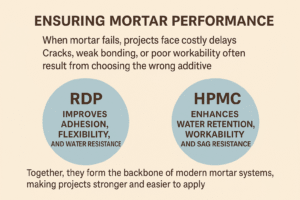HPMC (Hydroxypropyl Methylcellulose), a popular cellulose ether, is widely utilized across industries, from construction to food and pharmaceuticals. Discover why HPMC is essential and how its diverse uses benefit numerous products.
As a thickener, stabilizer, and binder, HPMC (or hydroxypropyl methylcellulose) plays a crucial role in enhancing product quality. It’s prized in construction, food, and pharmaceutical industries for its ability to improve texture, consistency, and stability across applications.
Let’s explore how HPMC is used in various industries, its advantages, and the factors influencing its price
HPMC in the Construction Industry: Improving Workability and Durability
HPMC is a vital ingredient in construction materials, particularly in products like dry mortars and tile adhesives, where it provides stability, water retention, and improved workabilit
In the construction industry, HPMC enhances adhesion, water retention, and material flexibility. This helps ensure cement and mortar can be applied evenly and cured properly, reducing cracks and prolonging the lifespan of structures.
HPMC, as a type of cellulose methyl ether, is highly valued for its water-retention properties, which allow cement and mortar to set evenly and reduce shrinkage. This enhances the quality and durability of materials in demanding applications. For builders and manufacturers, sourcing from reliable cellulose ether manufacturers ensures consistent quality, while keeping an eye on cellulose ether price trends is crucial to project planning.
Food Applications of HPMC: Texture and Stability for Quality
In food production, HPMC provides a plant-based solution for thickening and stabilizing food products, from sauces to dairy alternatives, without impacting flavor.
Food-grade HPMC, or cellulose hydroxypropyl methyl ether, improves texture, consistency, and stability in products like dressings and dairy substitutes. It’s ideal for low-fat and vegan formulations, providing a creamy texture without animal-derived ingredients.
HPMC’s unique structure allows it to replace traditional thickeners and emulsifiers, making it especially useful for vegan and low-fat products. It helps provide the creamy, smooth textures often required in food items such as ice creams and sauces. Since hydroxypropyl methylcellulose is generally recognized as safe (GRAS), it’s suitable for regular consumption. Monitoring HPMC price trends helps food manufacturers stay cost-effective while delivering high-quality, stable products to consumers.
Pharmaceutical Use of HPMC: A Reliable Binder and Controlled-Release Agent
In pharmaceuticals, HPMC functions as a binder and is key in controlled-release drug formulations, where it helps maintain consistent delivery and dosage accuracy.
Pharmaceutical-grade HPMC, or methyl cellulose ether, is widely used in tablets, capsules, and controlled-release drugs. Its stability, non-reactivity, and bio-compatibility make it ideal for extended drug release, which helps improve patient experience and treatment effectiveness.
HPMC’s ability to release active ingredients slowly and steadily makes it invaluable in time-release tablets, helping maintain stable drug levels in the body. Its use in capsule formation, where it serves as a vegan alternative to gelatin, is a significant advantage in modern pharmaceutical products. For pharmaceutical companies, choosing reliable cellulose ether manufacturers is essential for maintaining quality standards.
HPMC as a Thickening Agent: Why It’s Essential
Yes, HPMC is commonly used as a thickening agent across industries due to its strong viscosity and stability-enhancing properties.
HPMC provides consistent texture and thickness to products like sauces, creams, and personal care items. Its stability makes it suitable for long-lasting formulations in food and cosmetics, where consistency is key.
As a thickener, HPMC is invaluable in applications where a stable, uniform texture is essential. For instance, in food, it enhances mouthfeel, while in personal care products like shampoos and lotions, it improves spreadability. When it comes to pricing, the HPMC price may fluctuate based on demand and raw material costs, impacting product formulation costs in various sectors.
HPMC in Dishwashing Liquids: Stability and Consistency
In cleaning products, HPMC serves as a stabilizer and thickener, ensuring an even distribution of active ingredients and enhancing product consistency.
HPMC keeps dishwashing liquids from separating, maintaining their gel-like texture. This allows for consistent product performance and better adherence to dish surfaces during cleaning, enhancing the overall cleaning effect.
HPMC’s thickening properties help dishwashing liquids achieve the desired viscosity, which keeps ingredients evenly dispersed and improves application. By stabilizing the formula, it ensures that the liquid doesn’t separate or lose effectiveness over time. The right cellulose ether manufacturers provide stable HPMC at competitive prices, allowing for quality production across cleaning and household products.
Advantages of HPMC: Stability, Versatility, and Plant-Based Origins
HPMC offers numerous benefits, from its stability and non-toxicity to its plant-based origin, making it ideal for use in a variety of products, including vegan-friendly applications.
HPMC’s main advantages are its stability, thickening, and water retention capabilities. As a plant-based, safe additive, it’s suitable for products across industries, from vegan foods to pharmaceuticals and personal care items.
In food products, HPMC provides smooth, creamy textures without altering taste. For cosmetics, it’s a gentle and non-irritating thickener, suitable for sensitive skin formulations. In construction, it enhances the durability of materials by improving workability and reducing shrinkage. Access to quality HPMC from reputable cellulose ether manufacturers helps industries maintain high standards, while fluctuations in cellulose ether price can influence final product costs.
Potential Side Effects of HPMC in Food Products
Though generally safe, excessive intake of HPMC may cause mild digestive issues, such as bloating, but these effects are rare and minimal.
HPMC is widely recognized as safe (GRAS), though in large amounts, it might cause mild digestive discomfort. When used within approved levels, it does not have significant side effects, making it a reliable additive in food.
HPMC’s cellulose-based structure means it isn’t absorbed by the body, so it passes through the digestive system. Its inert nature contributes to its safety as a food additive. Reputable cellulose ether manufacturers follow stringent standards to ensure HPMC quality, and manufacturers monitor cellulose ether price to maintain a balance of cost and safety in food applications.
HPMC’s uses range from construction and pharmaceuticals to food and cosmetics, with benefits that include stability, safety, and consistency. With prices influenced by raw material costs and demand, HPMC remains a valuable ingredient across sectors, supporting high-quality, reliable products worldwide.



